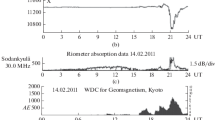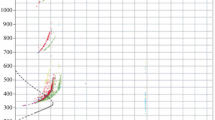We consider the behavior of the parameters of the ionospheric E s layers according to the vertical sounding at the Sodankylä observatory and oblique sounding at the Lovozero (Murmansk region)—Gor’kovskaya station (Leningrad region) path during a superstorm of March 17, 2015. Temporal and spatial behavior of these parameters is compared. It was found that the storm significantly distorted the normal course of variations of the sporadic E s layer characteristics. Specific behavior of the layers during a storm at points separated by about 300 km was detected. With the help of ray tracing calculations using the IRI model, oblique sounding ionograms were constructed for the radio path analyzed. Primary attention is given to the maximum usable frequency of the F 2 layer—MUF-F 2. Additionally, for the disturbed conditions where there is only a high-power E s layer on the experimental ionograms, the values of MUF-E s and the ratio K =MUF-E s/f o E s for various cutoff frequencies f o E s of the E s layer and its altitudes \( {h}_{E_s} \) are calculated within the framework of the well-known approximations. Calculations for the case of weak disturbance and semitransparent E s layers are carried out with the IRI model adapted to the current diagnostics parameters. It was found that the calculated and experimental values of MUF-F 2 are close to each other or coincide, while this cannot be said about MUF-E s. The calculated and experimental values of MUF-E s can be matched in the model of mirror reflection from a flat layer for intense layers and the model of the E layer for thick E s layers of low intensity.
Similar content being viewed by others
References
Yu.Cherniak and I. Zakharenkova, Earth, Planet and Space, 67, 151 (2015).
S.-R. Zhang, P. J.Erickson, J. C.Foster, et al., Geophys. Res. Lett ., 42, No. 13, 5132 (2015).
R.Kataoka, D. Shiota, E.Kilpua, et al., Geophys. Res. Lett ., 42, No. 13, 5155 (2015).
J. Liu, W.Wang, A.Burns, et al., J. Geophys. Res. Space Phys., 121, No. 1, 727 (2016).
N. M. Polekh, N.A. Zolotukhina, E.B.Romanova, et al., Geomagn. Aeron., 56, No. 5, 557 (2016).
B. A.Carter, E. Yizengaw, and R.Pradipta, J. Geophys. Res. Space Phys., 121), No. 1, 894 (2016).
D. V. Blagoveshchensky, Short Waves in the Anomalous Radio Channels, LAP LAMBERT Academic Publ. GmbH&Co, KG, Saarbr¨ucken (2011).
D. L.Wu, C.O.Ao, G. A. Hajj, et al., J. Geophys. Res., 110, No. A1, A01306 (2005).
X.Yue, W. S. Schreiner, Z. Zeng, et al., Atmos. Meas. Tech., 8, No. 1, 225 (2015).
S. E. Ritchie and F.Honary, Space Weather, 7, No. 7, S06005 (2009).
D. V. Blagoveshchensky and D. D. Rogov, Geomagn. Aeron., 51, No. 4, 534 (2011).
O. I. Razuvaev, Issled. Geomagn. A´eron. Fiz. Solntsa, No. 93, 3 (1991).
R. D. Hunsucker, R. B. Rose, and R. W. Adler, IEEE Trans. Antenn. Propag., 44, No. 3, 383 (1996).
B. G. Barabashov and M.M.Anishin, Tekh. Radiosvyazi, 19, No. 1, 1 (2013).
D. Bilitza, D. Altadill, Y. Zhang, et al., J. Space Weather Space Clim., 4, No. A07, 1 (2014).
K. Davies, Ionospheric Radio, Peter Peregrinus Ltd, London (1990).
T. Samardjiev, P.A.Bradley, Lj. R. Cander, M. I.Dick, Electron. Lett ., 29, No. 20, 1794 (1993).
P. A. Bradley, Adv. Space Res., 31, No. 3, 577 (2003).
Recommendation ITU-R, P.534-4, Intern. Telecommunication Union, Geneva (1999).
M.Pietrella and C.Bianchi, Adv. Space Res., 44, No. 1, 72 (2009).
V. V.Ryabtsev, T-Comm.—Telekom. Transport, No. S6, 23 (2009).
http://elbert.its.bldrdoc.gov/pc hf/hfwin32.html .
B. G. Barabashov and M.M.Anishin, Trydy NIIR, 99 (2002).
B.G.Barabashov, M.M.Anishin, and O.Y.Pelevin, Radio Sci ., 44, No. 1, RS0A18 (2009).
D. V. Blagoveshchensky, O. A. Mal’tseva, M.M.Anishin, et al., Tekh. Radiosvyazi, 24, No. 1, 16 (2015).
D. V. Blagoveshchensky, O. A. Mal’tseva, and M. M. Anishin, Tekh. Radiosvyazi, 27, No. 4, 5 (2015).
D. V. Blagoveshchensky, O. A. Mal’tseva, and M. M. Anishin, et al., Adv. Space Res., 57, No. 3, 821 (2016).
Author information
Authors and Affiliations
Corresponding author
Additional information
Translated from Izvestiya Vysshikh Uchebnykh Zavedenii, Radiofizika, Vol. 60, No. 06, pp. 509–520, June 2017.
Rights and permissions
About this article
Cite this article
Blagoveshchensky, D., Maltseva, O., Anishin, M.M. et al. Sporadic E S Layers at High Latitudes During a Magnetic Storm of March 17, 2015 According to the Vertical and Oblique Ionospheric Sounding Data. Radiophys Quantum El 60, 456–466 (2017). https://doi.org/10.1007/s11141-017-9814-y
Received:
Accepted:
Published:
Issue Date:
DOI: https://doi.org/10.1007/s11141-017-9814-y




